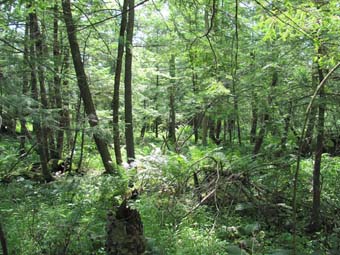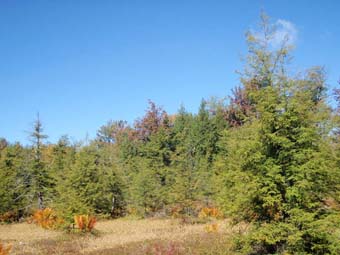Hemlock Palustrine Forest
System: Palustrine
Subsystem: Forest
PA Ecological Group(s): Basin Wetland
Global Rank:G4?
![]() rank interpretation
rank interpretation
State Rank: S3

General Description
These are wetland forests dominated or co-dominated by Eastern hemlock (Tsuga canadensis). The canopy may also contain a mixture of other conifers, including red spruce (Picea rubens)), tamarack (Larix laricina), and eastern white pine (Pinus strobus). Hardwoods may contribute up to 25% of the canopy; common species include red maple (Acer rubrum), yellow birch (Betula alleghaniensis), and black ash (Fraxinus nigra). There is generally a pronounced hummock and hollow microtopography. This community type may occur as a zone around a wetter community type of a more northern affinity. It may also occur in basins or on slopes fed by groundwater seepage. Rosebay (Rhododendron maximum) is often present, sometimes quite dense. Witherod (Viburnum cassinoides), swamp azalea (Rhododendron viscosum), winterberry (Ilex verticillata), and highbush blueberry (Vaccinium corymbosum) are also commonly associated with this type. Herbs include cinnamon fern (Osmunda cinnamomea), skunk-cabbage (Symplocarpus foetidus), sensitive fern (Onoclea sensibilis), partridge-berry (Mitchella repens), Canada mayflower (Maianthemum canadense), goldthread (Coptis trifolia), violets (Viola spp.), dewdrop (Dalibarda repens), star-flower (Trientalis borealis), and various grasses and sedges. There may be a strong bryophyte component, usually dominated by sphagnum moss (Sphagnum spp.).
This community probably often represents an older stage of the Hemlock – Mixed Hardwood Palustrine Forest. The trees tend to be larger, and the canopy more closed. The understory consists of similar species, but more sparse, sometimes absent in large patches.
Rank Justification
Vulnerable in the jurisdiction due to a restricted range, relatively few populations, recent and widespread declines, or other factors making it vulnerable to extirpation.
Identification
- Occurs on saturated soils in basins or depressions on the fringe of inundated areas or in backwater situations along rivers
- Dominance of Eastern hemlock (Tsuga canadensis) in the canopy.
- Hemlock trees may persist in the inundated portions of the depressions/basins by growing on hummocks.
Trees
Shrubs
Herbs
Bryophytes
* limited to sites with higher soil calcium
Vascular plant nomenclature follows Rhoads and Block (2007). Bryophyte nomenclature follows Crum and Anderson (1981).
International Vegetation Classification Associations:
USNVC Crosswalk:None
Representative Community Types:
Eastern Hemlock - Great Laurel Swamp (CEGL006279)
NatureServe Ecological Systems:
North-Central Appalachian Acidic Swamp (CES202.604)
NatureServe Group Level:
None
Origin of Concept
Fike, J. 1999. Terrestrial and palustrine plant communities of Pennsylvania. Pennsylvania Natural Diversity Inventory. Pennsylvania Department of Conservation and Recreation, Bureau of Forestry, Harrisburg, PA. 86 pp.
Pennsylvania Community Code*
UF : Hemlock Palustrine Forest
*(DCNR 1999, Stone 2006)
Similar Ecological Communities
Hemlock Palustrine Forests differ from Hemlock – Mixed Hardwood Palustrine Forests in that the conifer cover is higher in the Hemlock Palustrine Forests (greater than 75% cover). Hemlock – Mixed Hardwood Palustrine Woodlands differ from Hemlock Palustrine Forests in that Hemlock – Mixed Hardwood Palustrine Woodlands have a more open canopy (< 60% canopy cover) and typically a denser shrub layer.
Fike Crosswalk
Hemlock palustrine forest
Conservation Value
Hemlock Palustrine Forests provide habitat cover for ruffed grouse (Bonasa umbellus), turkey (Meleagris gallopavo), and snowshoe hare (Lepus americanus). This community also serves as a buffer for sediment and pollution runoff from adjacent developed lands by slowing the flow of surficial water causing sediment to settle within this wetland.
Threats
Hemlock Palustrine Forests are threatened by habitat alteration, deposition (sedimentation, agricultural runoff), and alterations to the hydrological regime (beaver dams, lowering of water tables). Clearing and development of adjacent land can lead to an accumulation of agricultural run-off and pollution, sedimentation, and insolation/thermal pollution. Hemlock communities are threatened by hemlock woolly adelgid (Adelgis tsugae) infestations. A. tsugae is an exotic pest insect that feeds on the twigs of the eastern hemlocks causing defoliation, bud mortality, and, eventually, tree mortality within as little as four years (Young et al. 1995). As tree mortality occurs, light availability increases due to the widening of canopy gaps and provides opportunities for the colonization of invasive plant species within the understory (Orwig and Foster 1998).
Management
A natural buffer around the wetland should be maintained in order to minimize nutrient runoff, pollution, and sedimentation. The potential for soil erosion based on soil texture, condition of the adjacent vegetation (mature forests vs. clearcuts), and the topography of the surrounding area (i.e., degree of slope) should be considered when establishing buffers. The buffer size should be increased if soils are erodible, adjacent vegetation has been logged, and the topography is steep as such factors could contribute to increased sedimentation and nutrient pollution. Direct impacts and habitat alteration should be avoided (e.g., roads, trails, filling of wetlands) and low impact alternatives (e.g., elevated footpaths, boardwalks, bridges) should be utilized in situations where accessing the wetland can not be avoided. Care should also be taken to control and prevent the spread of invasive species within the wetland. Alterations to groundwater sources should be minimized.
Research Needs
Variations may occur at ecoregional levels. There is a need to collect plot data to characterize variations and guide further classification of this community type. Community changes following hemlock defoliation from wooly adelgid infestations should also be studied.
Trends
Hemlock Palustrine Forests were probably more historically common but declined due to wetland draining/filling, alterations to groundwater discharge, clearing of the adjacent lands leading to sedimentation, and harvesting of Eastern hemlock bark for tannins. Wetland protection has most likely stabilized the decline of these communities. The relative trend for this community is declining due to hydrological alterations and tree mortalities resulting from hemlock woolly adelgid (Adelgis tsugae) infestations.
Range Map

Pennsylvania Range
Great Lakes Region, Glaciated NE, Glaciated NW, Pittsburgh Plateau, Pocono Plateau, Ridge and Valley, Unglaciated Allegheny Plateau.
Global Distribution
Northern Wisconsin, Michigan, northern Ohio, Maine, New Hampshire, Vermont, New Jersey, Maryland, New York, and Pennsylvania. It occurs in Canada in Ontario and possibly Quebec.
Cowardin, L.M., V. Carter, F.C. Golet, and E.T. La Roe. 1979. Classification of wetlands and deepwater habitats of the United States. U.S. Fish and Wildlife Service. Washington, D.C. 131 pp.
Edinger, Gregory J., D.J. Evans, Shane Gebauer, Timothy G. Howard, David M. Hunt, and Adele M. Olivero. 2002. Ecological Communities of New York State. Second Edition. A revised and expanded edition of Carol Reschke's Ecological Communities of New York State. New York Natural Heritage Program, New York State Department of Environmental Conservation. Albany, NY. 136 pp.
Fike, J. 1999. Terrestrial and palustrine plant communities of Pennsylvania. Pennsylvania Natural Diversity Inventory. Harrisburg, PA. 86 pp.
Horvath, Jamie L., Timothy A. Block, and Ann F. Rhoads. 2008. Description of the population, canopy cover, and associated vegetation of the globally rare sedge Carex polymorpha (Cyperaceae) in Nescopeck State Park, Pennsylvania. In Sedges: Uses, Diversity, and Systematics of the Cyperaceae, eds. R. Naczi and B. Ford. Missouri Botanical Garden Press, St. Louis, MO.
NatureServe. 2009. NatureServe Central Databases. Arlington, Virginia. USA
Orwig, D. A., and D. R. Foster. 1998. Forest response to the introduced hemlock woolly adelgid in southern New England, USA. Journal of the Torrey Botanical Society 125: 60:73.
Pennsylvania Department of Conservation and Natural Resources (DCNR). 1999. Inventory Manual of Procedure. For the Fourth State Forest Management Plan. Pennsylvania Bureau of Forestry, Division of Forest Advisory Service. Harrisburg, PA. 51 ppg.
Rhoads, Ann F. and Timothy A. Block. 2002. Nescopeck State Park; Inventory of PNDI-listed Plants and Plant Communities. Report submitted to DCNR, Bureau of State Parks.
Rhoads, Ann F. and Timothy A. Block. 2002. Survey of Natural Areas of Hickory Run State Park. Report submitted to DCNR, Bureau of State Parks.
Rhoads, Ann F. and Timothy A. Block. 2002. Tobyhanna State Park Natural Areas Survey. Report submitted to DCNR, Bureau of State Parks.
Stone, B., D. Gustafson, and B. Jones. 2006 (revised). Manual of Procedure for State Game Land Cover Typing. Commonwealth of Pennsylvania Game Commission, Bureau of Wildlife Habitat Management, Forest Inventory and Analysis Section, Forestry Division. Harrisburg, PA. 79 ppg.
Young, R. F., K. S. Shields, and G. P. Berlyn. 1995. Hemlock woolly adelgid (Homoptera, Adelgidae)-stylet bundle insertion and feeding sites. Annals of Entomological Society of America 88: 827:835.
Cite as:
Eichelberger, B. 2022. Pennsylvania Natural Heritage Program. Hemlock Palustrine Forest Factsheet. Available from: https://naturalheritage.state.pa.us/Community.aspx?=16028 Date Accessed: December 07, 2025
















